The impulses of an Egyptian king reverberate through numismatics today.
When creating my book, 100 Greatest U.S. Coins, the name King Farouk was attached to many of the most important coins. The Farouk pedigree captures the imagination like few other in the annals of numismatics. The collection of King Farouk was massive in scale and included innumerable rarities from around the world. He was the best customer for many of the most important rare coin dealers of the day - many of whom had to sweat out final payments from the Egyptian government.
When researching this article, it became evident there are many ways to collect coinage attached to the enigmatic king. Finding coins with his pedigree is exciting, but it is not the only way to collect Farouk numismatically. Egypt also produced coins and currency issued by Farouk from 1937 to 1950, many of which feature his image. The various auction catalogs of his collection are also quite interesting and very collectible.
When researching this article, it became evident there are many ways to collect coinage attached to the enigmatic king. Finding coins with his pedigree is exciting, but it is not the only way to collect Farouk numismatically. Egypt also produced coins and currency issued by Farouk from 1937 to 1950, many of which feature his image. The various auction catalogs of his collection are also quite interesting and very collectible.
King Farouk: "Playboy King"
King Farouk of Egypt was born on February 11, 1920, to King Fuad I and his wife, Nazli Sabri. He led a very sheltered life, and it was rumored that servants kissed the ground in front of him.
As a teenager, he went to the Royal Military Academy in Woolwich, England, where he met and befriended the Prince of Wales, later King Edward VIII. The future Egyptian king failed his entrance exams, having spent more time going to soccer matches with Edward and frequenting brothels than studying. However, his time in England was cut short by his father's death six months after arriving, forcing him to return to Egypt.
In Egypt, he was met with cheering crowds and a huge inheritance of five palaces, and millions of dollars. The political situation was tense at the time, but instead of trying to become a leader, he turned to indulgence, the scale of which proved to be epic.
He held a lavish coronation and later married a commoner, whose father he bribed with titles to get permission. They married in 1938 to great fanfare and at great expense - the wedding dress alone cost $30,000.
As World War II began, Farouk quarreled with the British over their influence in Egypt, and refused to contribute much to the war effort, keeping his decadent lifestyle and leaving his palace lights on during air raids, angering many. The British attempted to overthrow him, but Farouk acceded to their demands at the last second, securing his spot on the throne.
After this, Farouk fell further into degeneracy. He ate so much that he became obese and took items as "gifts" from families he visited. He even reportedly stole Winston Churchill’s gold watch during a visit.
As he enjoyed his decadent lifestyle, the country collapsed around him. Corrupt politicians siphoned off money, and he surrounded himself with a "Kitchen Cabinet" full of corruption. Farouk decided to go to war with Israel in 1948, and after a military disaster, his popularity plummeted.
Farouk decided to divorce his wife as she had not produced a son. This turned out to be a terrible idea, as she was loved by the Egyptian population - and his continued infidelity made things even worse.
He sought out another wife, hoping that the marriage would improve his popularity. But not only did he choose someone just a little over half his age, but he also chose someone already engaged, bribing her family to break the engagement.
His wedding increased his popularity, but his three-month-long honeymoon across Europe made that gain quickly disappear. Back at home, his ministers started a war with Britain over its control of their country, which did not go well for Egypt.
Because of the British retaliation to an Egyptian guerilla attack, a massive riot started that caused much of Cairo to burn, and Farouk’s downfall was imminent. A coup was planned, which Farouk tried to thwart by arresting all the officers involved. But it was too late. Farouk barricaded himself in a palace with his loyal troops, and even fought to defend his position himself. After a day of fighting, reinforcements for the coup arrived, and Farouk was forced to abdicate in 1952, leaving for Italy on the Royal Egyptian yacht, which he lived on the rest of his life.
In Italy, Farouk took on more mistresses and became known as "King of the Night" for all the time he spent in nightclubs. Farouk died after a midnight dinner at the age of 45, ending a decadent life of extravagance and debauchery.
His legacy of excessive collecting was another hallmark of the "Playboy King". During the Depression, the King became a massive customer of New York City dealer Hans Schulman and many others. He would buy entire collections from cash poor collectors hit hard by the global depression. His spending became such a drain on the Egyptian Treasury that he was forced to limit his spending to $10,000 per purchase. That sum would buy a lot of coins in the 1930s and 1940s.
After Farouk was deposed, his vast collections of coins, stamps, jewels and antiquities became property of the Egyptian government. The ensuing auctions would become legendary as one of the greatest buying opportunities of all-time.
Collecting Farouk
Egypt 1938 ROYAL WEDDING 500 PIASTRES graded NGC PF 66, commemorating the royal wedding of King Farouk to Queen Farida.
As mentioned above, Egypt issued coins under King Farouk from 1937 to 1950. Coins were issued in copper, silver and gold. Many of the silver coins are very interesting and quite affordable. Owning a coin issued by one of the greatest coin collectors of all time would be a fun addition to any collection.
A quick search of the Heritage Auctions' sales records will give you a good idea of what’s available on the market and prices you can expect to pay. You will find coins and currency to fit any budget. One of my favorites is the 1938 Royal Wedding gold coin. It is a stunning and tangible link to one of the most excessive Farouk events: his 1938 wedding.
When doing research for this article, I became aware of two B. Max Mehl auction sales offering coins from "His Majesty King Farouk I of Egypt." The 1948 sale is the more interesting of the two, with an important offering of Russian platinum coins and other gold coins from around the world. Mehl did not segregate the lots, so it’s difficult to know exactly which coins are from the collection of King Farouk. There was possibly an attempt to cull his collection, or the coins were being sold to pay for previous purchases. I assume the latter. These catalogs are not very rare and can be purchased for about $100 each. They would be an interesting companion to the Palace Collection Sale held in 1954.
After Farouk was deposed, the Egyptian government moved quickly to auction his various collections. There was no company in Egypt that could handle the sales, so the London firm Baldwins was enlisted to catalog and help assemble the coin sale. Sotheby and Co. produced the catalog and conducted the auction. The sale listed 2,798 lots containing over 8,500 gold coins from around the world and the United States. Dozens of coins listed in my 100 Greatest U.S. Coins book are represented in the sale, some of which are unique. The majority of the lots contained multiple coins, and the catalog is probably the most understated in history. The 1933 Double Eagle, which sold recently for over $18,000,000, was in a large lot described as follows: Lot 185 Twenty dollars, 1924, 1924-S, 1924-D, 1925, 1925-S, 1925-D, 1926, 1926-D 1927, 1927-S, 1928, 1929, 1930-S, 1931, 1932, 1933.
The 1933 Double Eagle was withdrawn from sale and later surfaced in the 1990s. Entire books have been written about this coin alone.
Hans Schulman was reportedly owed more than $300,000 by Farouk when he was deposed. The Egyptian government gave him credit for the amount he was owed to spend in the sale. He purchased coins for dealers and collectors around the world in an attempt to recover money owed. The famous dealer Abe Kosoff was also in attendance and his book Kosoff Remembers is an excellent source of information about the amazing sale.
The Palace Collection catalog of the Farouk Collection is actually quite scarce and will cost about $500 if you can find one. The books were poorly made and are somewhat fragile. The catalog is a very interesting read for any serious numismatist. For those wishing to examine the catalog without purchasing a copy, the book can be found on the Newman Portal.
With thousands of important coins sold in the three above-mentioned auctions, many can still be pedigreed to King Farouk. The task is not made easy because of the lack of photographs. The few coins that were illustrated are very poorly presented in the catalogs. Regardless, Farouk-pedigreed coins do show up sometimes. King Farouk must have been fond of pattern coinage, and many coins found today can be traced to his collection.
The sale of the Farouk Collection was one of the most important events in numismatic history. No other collector, with the exception of perhaps Virgil Brand, amassed such a treasure trove of important coins. King Farouk was the poster child for royal excess and his collecting habits are just one reflection of his compulsive behavior. Owning a tangible link to this infamous collector is achievable for most collectors and would be a fun addition to any collection.
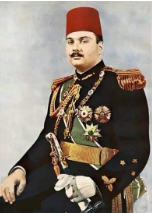 |
As a teenager, he went to the Royal Military Academy in Woolwich, England, where he met and befriended the Prince of Wales, later King Edward VIII. The future Egyptian king failed his entrance exams, having spent more time going to soccer matches with Edward and frequenting brothels than studying. However, his time in England was cut short by his father's death six months after arriving, forcing him to return to Egypt.
In Egypt, he was met with cheering crowds and a huge inheritance of five palaces, and millions of dollars. The political situation was tense at the time, but instead of trying to become a leader, he turned to indulgence, the scale of which proved to be epic.
He held a lavish coronation and later married a commoner, whose father he bribed with titles to get permission. They married in 1938 to great fanfare and at great expense - the wedding dress alone cost $30,000.
As World War II began, Farouk quarreled with the British over their influence in Egypt, and refused to contribute much to the war effort, keeping his decadent lifestyle and leaving his palace lights on during air raids, angering many. The British attempted to overthrow him, but Farouk acceded to their demands at the last second, securing his spot on the throne.
After this, Farouk fell further into degeneracy. He ate so much that he became obese and took items as "gifts" from families he visited. He even reportedly stole Winston Churchill’s gold watch during a visit.
As he enjoyed his decadent lifestyle, the country collapsed around him. Corrupt politicians siphoned off money, and he surrounded himself with a "Kitchen Cabinet" full of corruption. Farouk decided to go to war with Israel in 1948, and after a military disaster, his popularity plummeted.
Farouk decided to divorce his wife as she had not produced a son. This turned out to be a terrible idea, as she was loved by the Egyptian population - and his continued infidelity made things even worse.
He sought out another wife, hoping that the marriage would improve his popularity. But not only did he choose someone just a little over half his age, but he also chose someone already engaged, bribing her family to break the engagement.
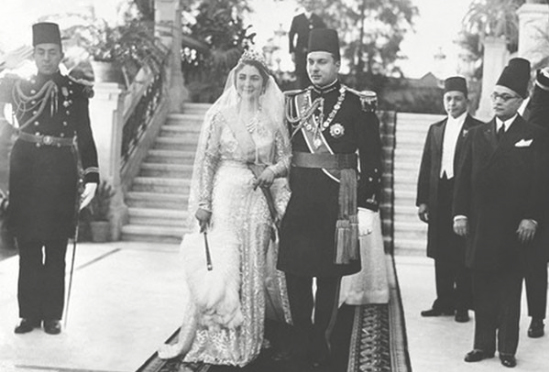 |
King Farouk and his bride at their extravagant 1938 wedding ceremony.
Before the marriage, he went on a massive bachelor party in Europe, gambling away vast sums of money and gorging himself on fine cuisine - Farouk lost over $150,000 in one night gambling. He came back to a warning of a revolt if he didn't do anything, so he went on a campaign to remove the British from Egypt, which kept him safe for some time.His wedding increased his popularity, but his three-month-long honeymoon across Europe made that gain quickly disappear. Back at home, his ministers started a war with Britain over its control of their country, which did not go well for Egypt.
Because of the British retaliation to an Egyptian guerilla attack, a massive riot started that caused much of Cairo to burn, and Farouk’s downfall was imminent. A coup was planned, which Farouk tried to thwart by arresting all the officers involved. But it was too late. Farouk barricaded himself in a palace with his loyal troops, and even fought to defend his position himself. After a day of fighting, reinforcements for the coup arrived, and Farouk was forced to abdicate in 1952, leaving for Italy on the Royal Egyptian yacht, which he lived on the rest of his life.
In Italy, Farouk took on more mistresses and became known as "King of the Night" for all the time he spent in nightclubs. Farouk died after a midnight dinner at the age of 45, ending a decadent life of extravagance and debauchery.
His legacy of excessive collecting was another hallmark of the "Playboy King". During the Depression, the King became a massive customer of New York City dealer Hans Schulman and many others. He would buy entire collections from cash poor collectors hit hard by the global depression. His spending became such a drain on the Egyptian Treasury that he was forced to limit his spending to $10,000 per purchase. That sum would buy a lot of coins in the 1930s and 1940s.
After Farouk was deposed, his vast collections of coins, stamps, jewels and antiquities became property of the Egyptian government. The ensuing auctions would become legendary as one of the greatest buying opportunities of all-time.
Collecting Farouk
Egyptian Coins and Currency
 |
Egypt 1938 ROYAL WEDDING 500 PIASTRES graded NGC PF 66, commemorating the royal wedding of King Farouk to Queen Farida.
As mentioned above, Egypt issued coins under King Farouk from 1937 to 1950. Coins were issued in copper, silver and gold. Many of the silver coins are very interesting and quite affordable. Owning a coin issued by one of the greatest coin collectors of all time would be a fun addition to any collection.
A quick search of the Heritage Auctions' sales records will give you a good idea of what’s available on the market and prices you can expect to pay. You will find coins and currency to fit any budget. One of my favorites is the 1938 Royal Wedding gold coin. It is a stunning and tangible link to one of the most excessive Farouk events: his 1938 wedding.
Auction Catalogs
When doing research for this article, I became aware of two B. Max Mehl auction sales offering coins from "His Majesty King Farouk I of Egypt." The 1948 sale is the more interesting of the two, with an important offering of Russian platinum coins and other gold coins from around the world. Mehl did not segregate the lots, so it’s difficult to know exactly which coins are from the collection of King Farouk. There was possibly an attempt to cull his collection, or the coins were being sold to pay for previous purchases. I assume the latter. These catalogs are not very rare and can be purchased for about $100 each. They would be an interesting companion to the Palace Collection Sale held in 1954.
After Farouk was deposed, the Egyptian government moved quickly to auction his various collections. There was no company in Egypt that could handle the sales, so the London firm Baldwins was enlisted to catalog and help assemble the coin sale. Sotheby and Co. produced the catalog and conducted the auction. The sale listed 2,798 lots containing over 8,500 gold coins from around the world and the United States. Dozens of coins listed in my 100 Greatest U.S. Coins book are represented in the sale, some of which are unique. The majority of the lots contained multiple coins, and the catalog is probably the most understated in history. The 1933 Double Eagle, which sold recently for over $18,000,000, was in a large lot described as follows: Lot 185 Twenty dollars, 1924, 1924-S, 1924-D, 1925, 1925-S, 1925-D, 1926, 1926-D 1927, 1927-S, 1928, 1929, 1930-S, 1931, 1932, 1933.
The 1933 Double Eagle was withdrawn from sale and later surfaced in the 1990s. Entire books have been written about this coin alone.
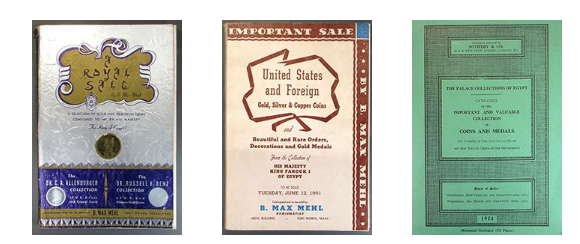 |
Catalogs from Farouk Collection auctions from the mid-20th century.
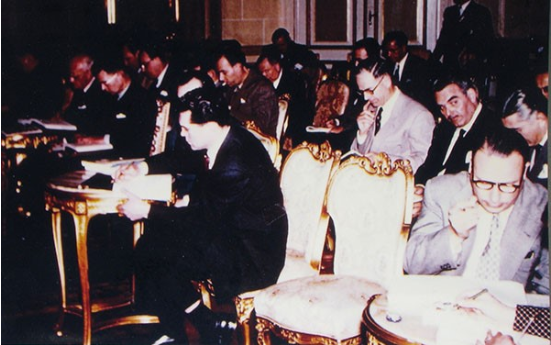 |
John J. Pittman and Hans Schulman at the Farouk Collection auction.
Suffice it to say the 1954 Palace Collection sale was one of the greatest buying opportunities in history. The famous collector John J. Pittman took out a mortgage on his house to have funds to bid in the auction. Many of the greatest coins in his collection were purchased at the sale. The above photo is previously unpublished (supplied by Ken Goldman) and features a very young John J. Pittman and Hans Schulman battling for lots.Hans Schulman was reportedly owed more than $300,000 by Farouk when he was deposed. The Egyptian government gave him credit for the amount he was owed to spend in the sale. He purchased coins for dealers and collectors around the world in an attempt to recover money owed. The famous dealer Abe Kosoff was also in attendance and his book Kosoff Remembers is an excellent source of information about the amazing sale.
The Palace Collection catalog of the Farouk Collection is actually quite scarce and will cost about $500 if you can find one. The books were poorly made and are somewhat fragile. The catalog is a very interesting read for any serious numismatist. For those wishing to examine the catalog without purchasing a copy, the book can be found on the Newman Portal.
Pedigreed Coins
With thousands of important coins sold in the three above-mentioned auctions, many can still be pedigreed to King Farouk. The task is not made easy because of the lack of photographs. The few coins that were illustrated are very poorly presented in the catalogs. Regardless, Farouk-pedigreed coins do show up sometimes. King Farouk must have been fond of pattern coinage, and many coins found today can be traced to his collection.
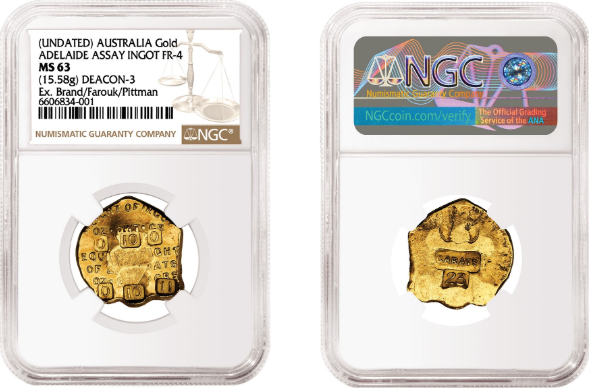 |
Australia Adelaide Assay Gold Ingot graded NGC MS 63 and pedigreed to the Farouk Collection
1871 J-1067a Half Dime graded NGC PF 60 and pedigreed to the Farouk Collection
France 1848A Essai 5 Francs graded NGC PF 65+ and pedigreed to the Farouk Collection
Due to the lack of hard evidence, it can often be difficult to positively attach the Farouk pedigree to a coin. Be sure to do your homework if offered one attributed to the collection.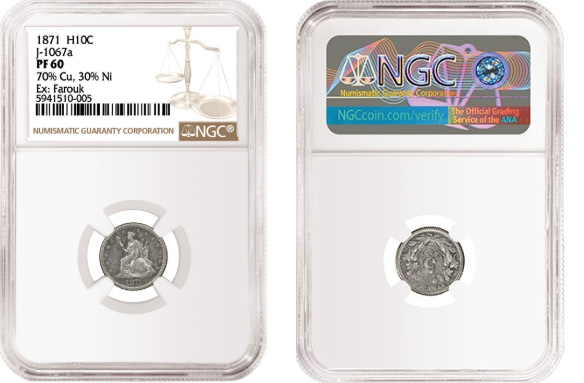 |
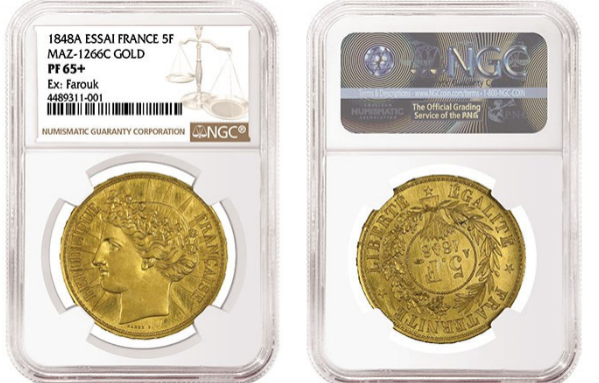 |
The sale of the Farouk Collection was one of the most important events in numismatic history. No other collector, with the exception of perhaps Virgil Brand, amassed such a treasure trove of important coins. King Farouk was the poster child for royal excess and his collecting habits are just one reflection of his compulsive behavior. Owning a tangible link to this infamous collector is achievable for most collectors and would be a fun addition to any collection.
